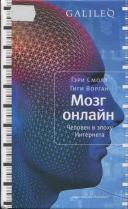Книга: Мозг онлайн. Человек в эпоху Интернета
Глава 7. Снова лицом к лицу
Глава 7. Снова лицом к лицу
212. Silverstein S. Real world 101: Colleges teach dining, taxes, life. Los Angeles Times. June 10, 2006
213. Ybarra O., Burnstein E., Winkielmon P., et al. Mental exercising through simple socializing: Social interaction promotes general cognitive functioning. Personality and Social Psycholog у Bulletin 2008; 34:248-59
214. Chayer C., Freedman M. Frontal lobe functions. Current Neurolog y and Neuroscience Reports 2001; 1:547.
215. Blakeslee S. A small part of the brain, and its profound effects. The New York Times. February 6, 2007
216. Naqvi N.H., Rudrauf D., Damasio H., Bechara A. Damage to the insula disrupts addiction to cigarette smoking. Science 2007; 315: 531–534.
217. Koenigs М., Young L, Adolphs R., et al. Damage to the prefrontal cortex increases utilitarian moral judgments. Nature 2007; 446:865-866
Carey B. Brain injury said to affect moral choices. The New York Times. March 22, 2007
218. King J. A., Blair J. R., Mitchell D. G. X, Dolan R. J., Burgess N. Doing the right thing: A common neural circuit for appropriate violent or compassionate behavior. Neuroimage 2006; 30:1069-1076
219. Williams L. M., Brown K. J., Palmer D., et al. The mellow years?: Neural basis of improving emotional stability over age. Journal of Neuroscience 2006; 26:6422-6430
220. Begley S. Parts of brain seem to get better with age. The Wall Street Journal. February 17, 2007
221. The teen driver: Committee on Injury, Violence, and Poison Prevention and Committee on Adolescence. Pediatrics 2006; 118:2570-2581
222. Centers for Disease Control and Prevention. Webbased Injury Statistics Query and Reporting System (WISQARS) [Online]. (2006). National Center for Injury Prevention and Control, Centers for Disease Control and Prevention (producer), www.cdc.gov/ncipc/wisqars
223. Williams et al. Journal of Neuroscience 2006: 26: 6422-6430
224. Leclerc C. M., Hess Т. M. Age differences in the bases for social judgments: Tests of a social expertise perspective. Experimental Aging Research 2007; 33:95-120
Begley S. The upside of aging. The Wall Street Journal. February 17, 2007.
225. Foreman J. It seems all those birthdays may be making you happy. Los Angeles Times. July 16, 2007
226. Bradley S. Foregrounding language. On the relationship between therapeutic words and the brain. Psychiatric Annals 2006; 36:289-294
Schwartz J.M., Stoessel P.W., Baxter L. R., Martin K. M., Phelps M. E. Systemic changes in cerebral glucose metabolic rate after successful behavior modification treatment of obsessive-compulsive disorder. Archives of General Psychiatry 1996; 53:109-113
227. Koezuka N.. Koo М., Allison K. R., et al. The relationship between sedentary activities and physical inactivity among adolescents: Results from the Canadian community health survey. Journal of Adolescent Health 2006; 39:515-522
228. Small et al. American Journal of Geriatric Psychiatry 2006; 14:538-545
229. Small G., Vorgan G. The Longevity Bible. Hyperion, New York, 2006. Begley S. How to keep your aging brain fi t: Aerobics. The Wall Street Journal. November 16, 2006
230. Wang A. T., Lee S.S., Sigman М., Dapretto M. Reading affect in the face and voice. Neural correlates of interpreting communicative intent in children and adolescents with autism spectrum disorders. Archives of General Psychiatry 2007; 64:698-708
231. Joinson A. N. Selfesteem, interpersonal risk, and preference for e-mail to face-to-face communication. CyberPsychology & Behavior 2004; 7:472-478
232. Joinson A. N. Cyberpsychology & Behavior 2004; 7:472-478
233. Suler J. The online disinhibition effect. Cyber-Psychology & Behavior 2004; 7:321-326
234. Harmon A. Internet gives teenage bullies weapons to wound from afar. The New York Times. August 26, 2004
235. New A. S., Hazlett E. A., Buchsbaum M. S., et al. Blunted prefrontal cortical 18fluorodeoxyglucose positron emission tomography response to metachlorophenylpiperazine in impulsive aggression. Arch Gen Psychiatry 2002; 59:621-629
236. Sharot Т., Riccardi A. M., Raio C. M., Phelps E. A. Neural mechanisms mediating optimism bias. Nature 2007: 450: 102-105
237. Carr L, Iacoboni М., Dubeau М.-C., Mazziotta J. C., Lenz G. L Neural mechanisms of empathy in humans: A relay from neural systems for imitation to limbic areas. Proceedings of the National Academy of Science USA 2003; 100:5497–5502.
238. Singer Т., Seymour B., O’Doherty J., Kaube H., Dolan R. J., Frith C. D. Empathy for pain involves the affective but not sensory components of pain. Science 2004; 303:1157-1162
239. Thompson С. Meet the life hackers. The New York Times. October 16, 2005.
240. Davidson R. J., Kabat-Zinn J., Schumacher J., et al. Alterations in brain and immune function produced by mindfulness meditation. Psychosomatic Medicine 2003; 65:564-570
Geirland J. Buddha on the brain: The hot new frontier of neuroscience: Meditation! (justask the Dalai Lama.) Wired. February 2006, www.wired.com/wired/archive/14.02/dalai.html
241. Small G., Vorgan G. The Longevity Bible. Hyperion, New York, 2006
242. Wing A. M. Motor control: Mechanisms of motor equivalence in handwriting. Current Biology 2000; 10:245-248
- Глава 1. Ваш мозг эволюционирует прямо сейчас
- Глава 2. Мозговая пропасть: технологии, разделившие поколения
- Глава 3. Зависимость от технологий
- Глава 4. Технологии и поведение: СДВГ, дети индиго и другие аномалии
- Глава 5. Хай-тек культура в обществе, политике и экономике
- Глава 6. Эволюция мозга: где мы теперь?
- Глава 7. Снова лицом к лицу
- Глава 8. Технологический багаж
- Глава 9. Перекинуть мост через «мозговую пропасть»
- Глава 7 Снова лицом к лицу
- 1.2. Предмет коммуникации как основа планирования кампаний по продвижению
- Письмо-ответ на обоснованную претензию
- Основания для выполнения проекта
- Удаляю Windows Messenger из автозапуска, но после перезагрузки программа снова запускается. С другими приложениями таког...
- Проблема с переключением языков. Значок есть, но не работает. Если через Панель управления удалить все языки и тут же сн...
- Основа для экспериментов
- Снова IUnknown
- Эвристическое правило номер 4: Симпатия – основа взаимосвязи и доверия
- И снова о штампах и клише
- Принцип 8. Еще раз вернемся к основам
- Глава 18 Основатель amazon раскрывает секреты успешного бизнеса




